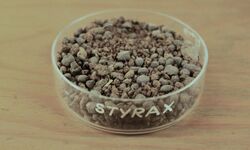Storax balsam
Topic: Biology
 From HandWiki - Reading time: 3 min
From HandWiki - Reading time: 3 min
Storax (Latin: storax; Greek: στύραξ, stúrax),[1][2][3][4][5] often commercially sold as styrax, is a natural resin isolated from the wounded bark of Liquidambar orientalis Mill. (Asia Minor) and Liquidambar styraciflua L. (Central America) (Hamamelidaceae).[6] It is distinct from benzoin (also called "storax"), a similar resin obtained from the Styracaceae plant family.
Composition
Purified storax contains circa 33 to 50% storesin, an alcoholic resin, both free and as cinnamic esters. Contains 5 to 15% cinnamic acid, 5 to 15% cinnamyl cinnamate, circa 10% phenylpropyl cinnamate; small amounts of ethyl cinnamate, benzyl cinnamate, and styrene, Some may contain traces of vanillin. Some sources report a resin containing triterpenic acids (oleanolic and 3-epioleanolic acids).[7]
Uses
Storax has a pleasant, floral/lilac, leathery, balsamic smell. Storax and its derivatives (resinoid, essential oil, absolute) are used as flavors, fragrances, and in pharmaceuticals (Friar's Balsam).[6][8][9]
American storax resin (Liquidambar styraciflua) is chewed like gum to freshen breath and clean teeth.[10]
History
In the Bible, Hosea 3:13 speaks of the Storax trees. Mnesimachus, Aristotle, Theophrastus (Historia Plantarum), Herodotus, and Strabo also mention the storax tree and its balsam. In Ancient Greece , storax also denoted the spike at the lower end of a spearshaft.[11]
Pliny (Historia Naturalis 12.98, 15.26; 24.24) notes the use of storax as a perfume, while Scribonius Largus drank wine flavored with storax.[12] Ciris mentions storax as a fragrant hair dye.[13] Dioscorides (De materia medica 1.79) reports its use as incense, similar to frankincense, having expectorant and soothing properties.[14]
The 10th century Arab historian al-Masudi listed storax gum (mayʿa) as a spice in his book Murūdj al-dhahab (Meadows of Gold).[15]
Chao Ju-Kuan, a 13th century trade commissioner in Fukien province, described liquid storax gum as a product of Ta-shï (the Arabs).[16]
Linnaeus, who determined the scientific names of plants, thought that storax was extracted from the tree called in modern Hebrew livneh refu'i which he termed Styrax officinalis. However in the light of tests made in Israel it is very doubtful if a sap with medicinal or aromatic qualities can be extracted from this tree. The storax of the ancients was probably extracted from a different tree, seemingly from the Liquidambar orientalis which grows wild in northern Syria, and may even have been grown in Israel; from it is extracted an aromatic sap with healing qualities called storax liquidis. This may possibly be the biblical balm, though other sources conclude that the biblical balm is Balsam (opobalsamum).[17]
This species originated in the Southern regions of Mesopotamia, present day Iraq and in particular Babylon. Babylonians used it for respiratory related diseases. 8
In the nineteenth century, styrene was isolated by distillation of storax balsam.[18]
In North Africa, for mystical purposes, women burn benzoin and storax in potsherds.[19]
Safety
Storax resin is "generally regarded as safe" (GRAS), but at low levels, for example, circa 15 ppm in candy and 25 ppm in baked goods.[7]
References
- ↑ Company, Houghton Mifflin Harcourt Publishing. "The American Heritage Dictionary entry: storax". https://www.ahdictionary.com/word/search.html?q=storax.
- ↑ "Definition of STORAX" (in en). https://www.merriam-webster.com/dictionary/storax.
- ↑ "storax | Definition of storax in English by Oxford Dictionaries". https://en.oxforddictionaries.com/definition/storax.
- ↑ "Storax dictionary definition | storax defined" (in en). http://www.yourdictionary.com/storax.
- ↑ "Storax definition and meaning | Collins English Dictionary" (in en). https://www.collinsdictionary.com/dictionary/english/storax.
- ↑ 6.0 6.1 Karl-Georg Fahlbusch (2007), "Flavors and Fragrances", Ullmann's Encyclopedia of Industrial Chemistry (7th ed.), Wiley, p. 115
- ↑ 7.0 7.1 James A. Duke (2008), Duke's Handbook of Medicinal Plants of the Bible, Taylor & Francis, pp. 258–259
- ↑ George A. Burdock (2010), Fenaroli's Handbook of Flavor Ingredients (6th ed.), Taylor & Francis, pp. 1853–1854
- ↑ "Compound Benzoin Tincture", British Pharmacopoeia, 3, 2009
- ↑ James A. Duke (2008), Duke's Handbook of Medicinal Plants of the Bible, Taylor & Francis, p. 445
- ↑ Henry George Liddell; Robert Scott, eds. (1897), "στύραξ", Greek-English Lexicon (8th ed.), Harper & Brothers, p. 1442, https://archive.org/details/greekenglishlex00lidduoft
- ↑ Oxford Latin Dictionary, Oxford University Press, 1968, p. 1832
- ↑ Oxford Latin Dictionary, Oxford University Press, 1968, p. 1825
- ↑ Dioscorides (1902), Julius Berendes, ed., De materia medica, PharmaWiki.ch, p. 89, http://www.pharmawiki.ch/materiamedica/images/Dioskurides.pdf, retrieved 2014-10-10
- ↑ A. Dietrich (2004), "AFĀWĪH", The Encyclopaedia of Islam, 12 (supplement) (2nd ed.), Brill, pp. 42–43
- ↑ Hirth, F.; Rockhill, W. W. (1911). Chau Ju-Kua: His Work on the Chinese and Arab Trade in the Twelfth and Thirteenth Centuries, entitled Chu Fan Chï. Saint Petersburg: Printing Office of Imperial Academy of Sciences. pp. 200. https://archive.org/details/chaujukuahiswork00chao/page/200/mode/2up.
- ↑ Jehuda Feliks (2007), "Storax", Encyclopaedia Judaica, 19 (2nd ed.), Thomson Gale, p. 238
- ↑ Denis H. James; William M. Castor (2007), "Styrene", Ullmann's Encyclopedia of Industrial Chemistry (7th ed.), Wiley, p. 1
- ↑ D. S. Margoliouth (1997), "ḲĀDIRIYYA", The Encyclopaedia of Islam, 4 (2nd ed.), Brill, pp. 380–383
 |
 KSF
KSF
